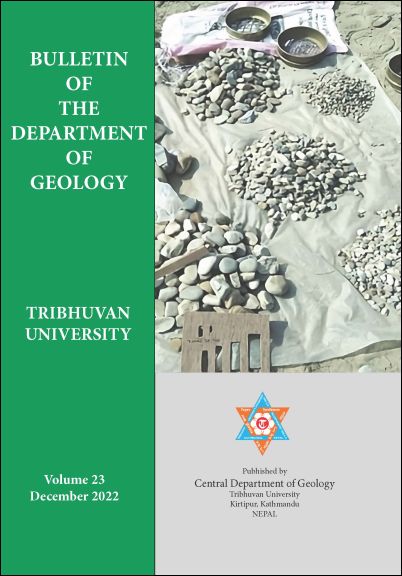Engineering Properties of Aggregates for Railway Ballast, Rapati Nadi, Central Nepal Sub-Himalaya
DOI:
https://doi.org/10.3126/bdg.v23i1.64775Keywords:
Aggregate, Geotechnical properties, Railway Ballast, Engineering properties, Los Angeles Abrasion ValueAbstract
Nepal has proposed various railway projects, such as the East-West Railway, Kathmandu Metro Railway, and Raxaul-Kathmandu Railway. Good ballasts are always sought in the projects to diminish maintenance cost. Sediments from the Rapati Nadi (River) in central Nepal are among probable sources of ballasts as those sediments are rich in quartzite clasts. To meet the ballast requirements for railway projects, the study assessed the physical, mechanical and durability properties of alluvial deposit aggregates.
The compositional analysis yielded maximum percentage of quartzite followed by sandstone and others. The aggregates yielded uniformity in gradation. Flakiness and Elongation Indices of the tested samples ranged from 11.18 to 24.10% and from 13.07 to 42.77%, respectively. Specific gravity exceeded 2.4. Aggregate Impact Value, Aggregate Crushing Value and Los Angeles Value of the tested samples were respectively 4.4-13.2%, 10.20-17.67% and 15.75-34.25%. Similarly, the point load strength index ranged from 3.69 to 6.57 MPa, and the Sodium Sulphate Soundness Values ranged from 0.96 to 2.06%. All the test results satisfied the conditions based on IS specification in the context of aggregate shape, crushing strength, impact strength, and durability against abrasion. When the results of different indices and values are rated based on their higher, intermediate and lower ranges, all the samples fall in the range of the high rating. Thus it shows suitability of aggregates of the Rapati Nadi and sediment aggregates deposited between Basantapur and Bastipur seem better compared to other locations.
Downloads
Downloads
Published
How to Cite
Issue
Section
License
© Central Department of Geology, Tribhuvan University, Nepal

